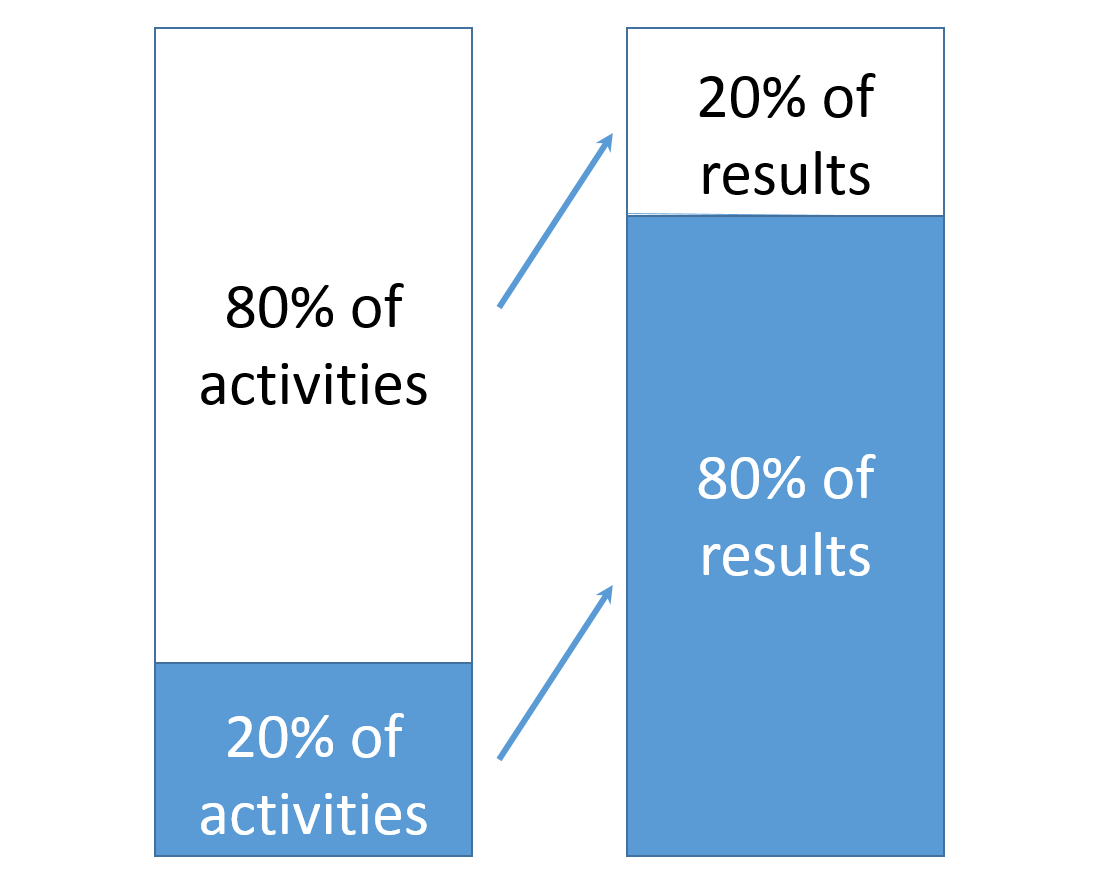- Home
- 7 Steps of Goal Setting
- Pareto Principle
The Power of Choice – The Pareto Principle and Discerning the Right Stuff
The Pareto principle is the filter that can protect us from ourselves and our natural response to having too many things on our plate.
After all, isn't it flattering when the boss comes up to your desk and offers you that high profile project! You know that the co-worker on the project is fussy and difficult but ah the kudos of the offer! Similarly, it can be very rewarding to look at your list of clients and see that it has risen from 20 to 100 in such a short time.
The temptation is to think – well I must be doing something right if all this work is coming my way.
It is right then that we need to be careful – the trouble is we can often be tempted to take on far more than we can reasonably deliver with the quality that we have become known for.
We find ourselves working longer, missing deadlines or compromising quality with no appreciable impact on our performance. In the melee we find ourselves apologizing a lot more often than we are comfortable with and start to be concerned about our reputation for getting things done.
This is where the Pareto principle can help.
What is the Pareto Principle?
The Pareto principle separates the vital few from the many less fruitful activities. It is named after the highly influential Vilfredo Pareto, an Italian economist of the late 19th early 20th Century, who observed that 80% of the wealth was owned by 20% of Italians and whose thinking has underpinned much of micro economic thinking.
Pareto’s concept of focusing on what is going to make a difference is neatly captured in his own words:
"If you're Noah, and your ark is about to sink, look for the elephants first, because you can throw over a bunch of cats, dogs, squirrels, and everything else that is just a small animal and your ark will keep sinking. But if you can find one elephant to get overboard, you're in much better shape."
But how does this apply to you and your use of time and how can you boost productivity?
More generally the 80/20 distribution which has come to be known as the Pareto Principle can be observed in many other areas of life. For example:
- 20% of IT problems take up 80% of IT department time
- 20% of movies generate 80% of income
- 20% of workers generate 80% of results
- 20% of clients generate 80% of revenue
The trick for you is to identify your 20%.This is where you exercise Choice. Choice is critical to the KNOW it part of Know it Plan it Do it.
It is critical for you to know on any given day, in any given moment that you are spending your time on worthy activities. The whole point is to avoid the disappointment and despair of slogging out your day only to find that you have really not got anywhere or contributed much to your success or work goals.
Check out these 3 steps to use 80/20 principle to help you choose the right work to boost your effectiveness and get the results you want.
3 Steps to use the Pareto Principle
The Pareto Principle provides you with a priority system to validate incoming tasks against your obligations.
To build this priority system you need to have three things:
- Know what your key result areas or goals are? In other words what is most important.
- Use the Pareto principle to prioritize your tasks.
- Ensure that you protect these vital few activities from the trivial many.
1. Identify your key result areas
In today's world of information overload and real-time response, it is not unusual to be faced with a dozen tasks that demand your attention.
You need to have a compass that keeps what is important on the front-burner of your thoughts.
Using this at work and at home
Your compass are the goals or objectives that you are aiming to achieve in this week, this quarter, or this year. Your top priorities are those that are aligned with your performance criteria, key result areas, or goals.
Any incoming information or requests for your time need to be assessed against your goals and objectives. Once this is down you can assign the incoming a task a priority.
At work these are those things that you are measured against. In your personal life they are the pursuit of those things that matter most to you or your family.
Use the 1:1:5 Planning Sheet to create a road map of your goals and their supporting actions.
The 80 20 rule is a prioritizing system that can dramatically change your life.
Note:
If your goals are not aligned with the 80 20 rule, ask yourself the following questions:
- Are these someone else's goals?
- Do I need to add more goals/objectives?
- Am I doing what is important?
- Am I spending too long in the urgent/crises mode of this matrix?
2. Use the Pareto Principle to set priorities
List all the activities that you have to do over the next week. But don't fall into the trap of using your to do list as a way to manage your time.
Now put an A, B or C next to them:
- 'A' is for your most important activities (those top 20%),
- 'B' are somewhat important (60%), and
- 'C' are your least important activities (bottom 20%).
Put a time limit on those activities that you have classed as most important. How long are each of your 'A' activities going to take?
3. Protect the vital few from the trivial many
Gather up all of your top priority actions that you have to do next week (if you have followed the process, each of these actions should have a duration next to them!)
The next step is to make time for these most important activities, rather than trying to find time later on.
To do this, consider these 6 steps to scheduling.
Windows software solution
I really like Achieve Planner scheduling software, that is a complete time management software that protects your time (in advance) for the most important activities.
You can download their free 30 day trial at your convenience.
Related articles on time management in the workplace
 Strategies to reduce interruptions and improve focus Strategies to reduce interruptions and improve focus |
 Manage meetings effectively Manage meetings effectively |






New! Comments
Have your say about what you just read! Leave me a comment in the box below.